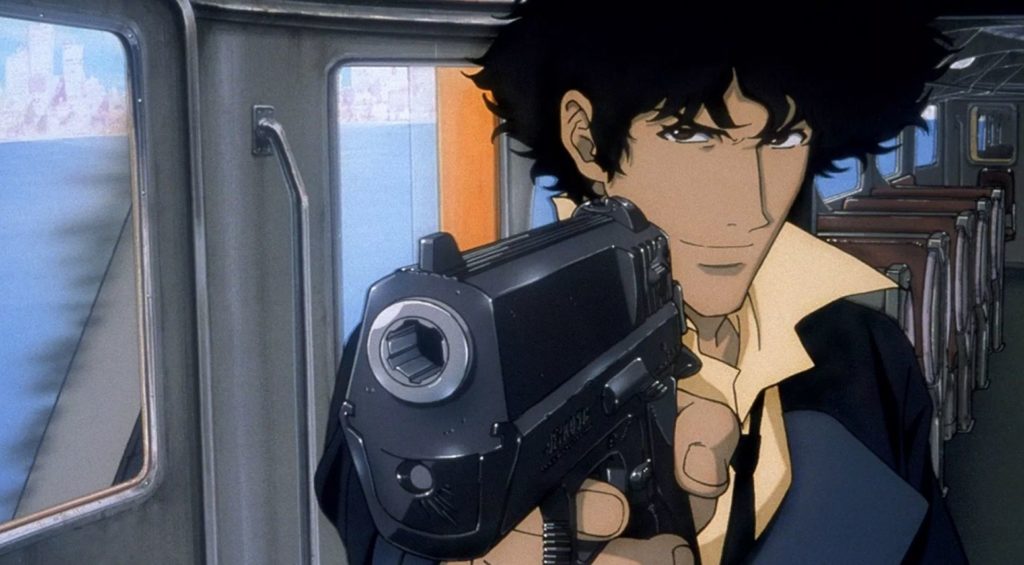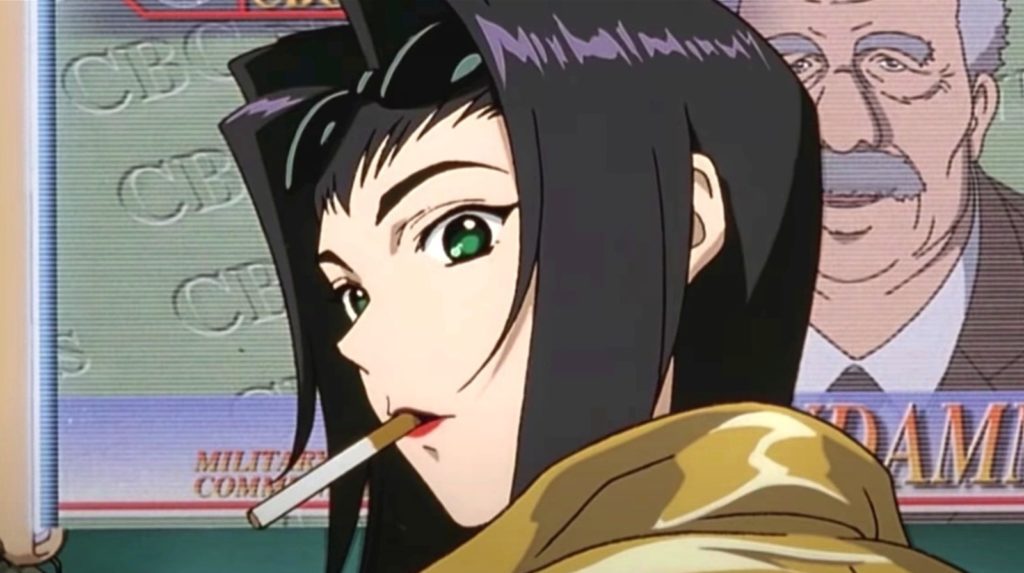Cowboy Bebop: The Movie
October 24, 2023 · 0 comments
By Andrew Osmond.

Mars: 2071. Spike Spiegel is a “cowboy” bounty hunter, loosely allied with cyborg ex-cop Jet, gambler Faye and female hacker Edward. Faye is tracking a criminal hacker called Lee when a tanker explodes on a highway, spreading an unknown virus that attacks the brain. With a record bounty on the perpetrators’ heads, the team start separate investigations.
Created as a side-story to the anime TV series of the same name, Cowboy Bebop: The Movie remains accessible to newcomers. Though it’s set in a future replete with sci-fi hardware, it’s essentially a hard-boiled detective thriller in anime form. The mystery is punctuated with satisfyingly meaty fights and a sprinkling of existential angst. The whole is held together by the lanky central figure of Spike, a “cowboy” bounty hunter whose narcoleptic languor and stork-like gait give way to lightning speed and savagery in the fight set pieces.
For readers familiar with the TV Cowboy Bebop, the film was made three years after the series. However, it emphatically isn’t a sequel to the last TV episode, which we won’t spoil here. Rather, the film is a midquel that shows a previously untold adventure of the Bebop team, and it officially slots between parts 22 and 23 of the series. It may be unintentional, but if you’ve seen the series first, then there’s a slight Pulp Fiction vibe to see the Bebop anime ending midway through its own timeline, all of our favourite characters working together like Tarantino’s hitmen Jules and Vincent… though we’ve already seen that it won’t last.

Set in a universe that is partly inspired by 1970s blaxploitation, and partly inspired by Bruce Lee movies, Cowboy Bebop: The Movie – directed, like the TV series, by Shinichiro Watanabe – takes place in a future solar system crisscrossed by teleporter freeways. Its look is deliberately designed to recall the pulpy quick-fixes of hack science fiction, with rockets stuck on big-rig trucks, and religious cults stuck in orbit to give them a sci-fi tweak.
The film’s city, called Alba or Alva, is ostensibly on Mars though much of the movie’s action could be set on present-day Earth. That’s true to the ethos of the TV Bebop; Watanabe would later use a very similar device in his 2019 series Carole & Tuesday, which is also set on a city on Mars (Alba). The metropolis in the Bebop film is transnational, with a Manhattan-style skyline sporting prominent Twin Towers, a fight on a Tokyo Tower clone, and a thriving Moroccan district brimming with African exoticism, all slatted shadows and yellow light.

The setting is rendered with polished hyperrealism which, combined with non-cartoony animation (only the loose-limbed girl Edward approaches caricature), prompts the question why the film wasn’t produced in live-action. The answer seems to be to heighten the larger-than-life melodrama of the story, and, of course, the more recent Netflix live-action adaptation of Cowboy Bebop didn’t fare so well.
The main fights are well composed, conveying a keen sense of dramatic confrontation. The tower battle is lit by fireworks and floating lanterns, while an earlier fight takes place on an elevated train racing high over the city bay. (That’s surely an homage to a milestone of 1970s action cinema, William Friedkin’s The French Connection, with its famous set-piece aboard an elevated train.) There’s also the suggestion of a link between the Bebop film’s animated form and its thematic content. A minor baddie, introduced playing a video game from the 1980s, is a techno-nerd who can’t tell life from virtuality.
Later we discover that the main adversary, the solipsistic, solitaire-playing Vincent, thinks existence is a dream after his mind has been scrambled. If you’ve watched the series, you’ll know that’s how Spike sees the world too, making the characters spiritual doubles. The victims of a mysterious virus see glowing butterflies that swarm over the final fight. They’re both an analogue to the doves that counterpoint live-action violence in John Woo’s films and a nod to the philosopher Zhuangzi’s aphorism about a man and a butterfly, each uncertain which is dreaming the other.

Cowboy Bebop’s fortunes as a movie seem to have been cursed by the devil himself. When finally released after a delayed production, it was slated to hit American cinemas slap-bang in the middle of hysteria about 9-11. Its concentration on the motives of a terrorist turned into a sudden spell of cold feet on the part of its distributors, and it was consigned to the movie sin-bin for a while, along with Rintaro’s Metropolis, which featured a disturbingly familiar sight of a large building crumbling into dust.
At least Cowboy Bebop: The Movie played its terrorist scenario straight, dialling down most of the comedy from the TV series. Try comparing it to the loony “Cowboy Funk” TV episode, whose bomber blows up buildings while dressed as a teddy bear!
Even when the film first hit the UK with a 15-week run at the prestigious ICA cinema on Pall Mall in 2003, its coughing, plague-ridden characters evoked unpleasant reminders of SARS, a different kind of terror then threatening the Far East. Quite possibly, it has only now got the chance to shine in its own right.
Cowboy Bebop is screening at this year’s Scotland Loves Anime.
Leave a Reply